Both the Atlas and the XC90 have standard driver and passenger frontal airbags, front side-impact airbags, side-impact head airbags, front seatbelt pretensioners, height adjustable front shoulder belts, plastic fuel tanks, four-wheel antilock brakes, traction control, electronic stability systems to prevent skidding, crash mitigating brakes, post-collision automatic braking systems, daytime running lights, blind spot warning systems, rearview cameras, rear cross-path warning, available all wheel drive, lane departure warning systems and around view monitors.
The National Highway Traffic Safety Administration does side impact tests on new vehicles. In this test, which crashes the vehicle into a flat barrier at 38.5 MPH, results indicate that the Volkswagen Atlas is safer than the Volvo XC90:
|
|
Atlas |
XC90 |
|
|
Front Seat |
|
| STARS |
5 Stars |
5 Stars |
| Chest Movement |
.5 inches |
.7 inches |
| Abdominal Force |
48 lbs. |
153 lbs. |
|
|
Rear Seat |
|
| STARS |
5 Stars |
5 Stars |
| Spine Acceleration |
39 G’s |
40 G’s |
| Hip Force |
527 lbs. |
608 lbs. |
New test not comparable to pre-2011 test results. More stars = Better. Lower test results = Better.
Instrumented handling tests conducted by the National Highway Traffic Safety Administration and analysis of its dimensions indicate that the Atlas is .8% to 5.5% less likely to roll over than the XC90.
For its top level performance in IIHS driver and passenger-side small overlap frontal, moderate overlap frontal, side impact, roof strength and head restraint tests, with its optional front crash prevention system, and its headlight’s “Good” rating, the Insurance Institute for Highway Safety grants the Atlas its highest rating: “Top Safety Pick Plus” for 2019, a rating granted to only 125 vehicles tested by the IIHS. The XC90 is only a standard “Top Safety Pick” for 2019.


